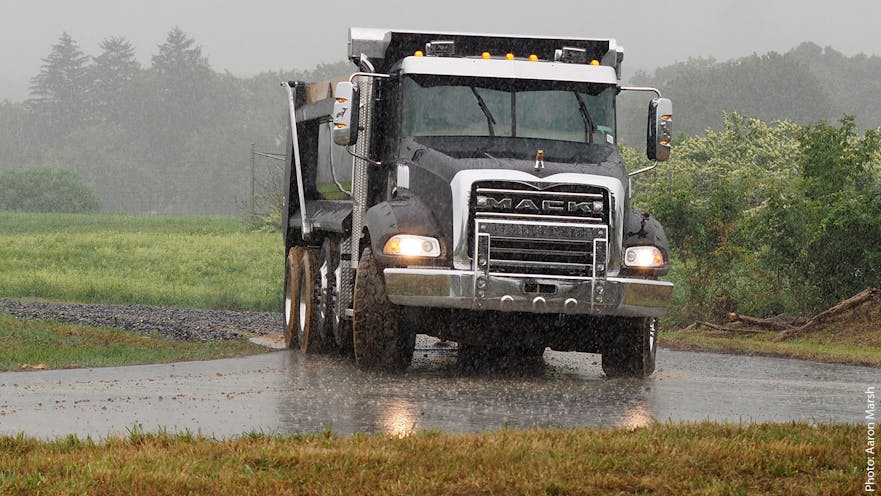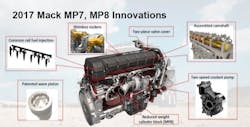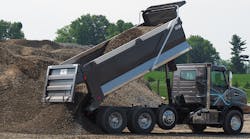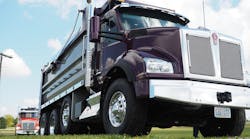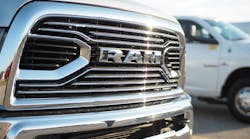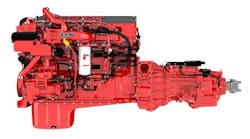"You can go as fast as you feel comfortable with — the faster you go, the closer our heads will get to the ceiling," quipped Tim Wrinkle, construction product manager for Mack Trucks. I should've taken him more literally.
"You're not gonna break it," he reassured me. "It's a Mack."
We were in a Mack Granite Axle Back dump truck sporting a 2017 MP8 13L diesel rated at 445 hp and 1,860 lbs.-ft. of torque and loaded to 69,850 lbs. on an off-road, mostly dirt-and-gravel track. Reporters were at Mack's Allentown, PA facility last Thursday testing out some of the OEM's latest powertrain hardware and technology. It was a full-on downpour just then, and the test course's dirt road had become a mud slosh as I ripped toward some big, engineered bumps probably too quickly, banging over a few of them.
Wrinkle's and my seat flew up and down like seesaws and the grin on my face couldn't have been any wider. And no, nothing even came close to breaking.
The 13L Mack engine felt smooth with power to spare, but another real highlight was the company's updated mDrive automated manual transmission. The dump had a 12-speed with two additional creeper gears, allowing surprisingly precise, incremental control for such a heavy piece of equipment.
We stopped the truck in the middle of a steep grade, and the mDrive — sensing both load and grade and in "Drive" — didn't even need the super-low-reduction creeper gears to get going. But to get a feel for its performance we selected the lowest creeper gear, which was very easy to do with the transmission's solid, straightforward "plus" and "minus" buttons, providing a 32:1 reduction ratio. Hitting the accelerator, the truck's RPMs spooled up while speed held rock-steady at about 0.5 mph.
Mack's "grade gripper" technology gives the driver three seconds to move from brake to accelerator, holding the truck on a hill without any rollback. We tried the same mid-grade full-stop exercise in reverse as well, and the dump showed the same smooth control.
You'll notice in the slideshow that many of these test Macks came dressed in black, but you might've also spotted the gold Mack bulldog ornament on most of their hoods. That indicates a particular seamless pedigree, explained Stuart Russoli, highway and powertrain product marketing manager for Mack Trucks.
"This has the gold bulldog, which tells you you've got a Mack engine, Mack transmission and Mack rear axle," Russoli noted. "If you don't have a complete Mack powertrain, you get a silver bulldog."
On-hand at the ride-and-drive event also was Roy Horton, director of product strategy for Mack Trucks, who gave a rundown of the company's powertrain updates put in place to meet — and exceed — 2017 greenhouse gas emissions and fuel economy requirements. The trucks showed finesse and control along with upgraded power thanks to their predominantly all-Mack powertrains. Reporters ran the trucks on both on- and off-pavement test tracks in an informal competition, often having to stay within tight courses or backing up as close as possible to construction cones without hitting them.
One reporter (no names named, of course) shows how not to get points in that competition:
2017 Mack tech highlights
"We took our already proven engine platform and evolved it to make it even better: higher performance, improved fuel efficiency and simplified maintenance," Horton said in explaining the 2017 powertrain enhancements.
For the MP7 11L and MP8 13L engines, common rail fuel injection and Mack's patented Wave Piston bring fuel economy improvements, and a new, two-speed coolant pump for select engine ratings allows further gains. Shimless rockers and a two-piece valve cover reduce service time and simplify the service process, Horton said, and an assembled camshaft and new cylinder block for the MP8 reduce engine block weight by 27 lbs. and 44 lbs., respectively.
"For the MP7, we have a new higher rating," Horton noted. "The old rating for the MP7 was 405 hp, and we bumped that up to 425 hp. Now we have 13L power in an 11L package, and that's important for our customers who are weight-conscious; between the 11L and 13L engines, it's about a 400-lb. difference, so that's significant."
Depending on application and baseline measurement, the 2017 MP7 engines deliver 2.1-5.1% better fuel economy, he contended. The new MP7s begin production in January 2017.
For the MP8, all 445-hp and 505-hp engine ratings now get 1,860 lbs.-ft. of torque. "We've upgraded the power and torque curves along with meeting regulations," Horton said, "and we also improved fuel economy by 2.5-5%." The 2017 MP8s are available for order now, and production starts in October.
In addition, the MP8 will be available with turbo compounding in mid-2017. "That just captures waste energy and puts it back into the crankshaft," explained Horton. "You can use that to improve power and performance or to improve fuel economy, and we choose to use it to improve fuel economy.
"It brings an 8.1-8.8% increase vs. our 2014 baseline," he noted.
